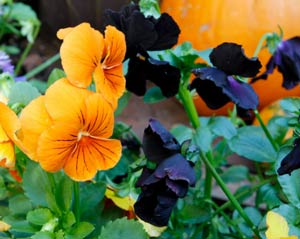Pumpkins, Pansies, and Parsnips
Fall means the 3 P's for color

Searcy, Ark. – It's fall and that means it’s time to think about pumpkins, pansies, and parsnips. If your yard needs some instant color and a pick-me-up, you have plenty of pumpkins and gourds to choose from. Pumpkins don’t just mean orange; there are whites, striped, splotched, green, almost black, and yellow. The skin may be smooth or rough, with some looking like they are covered in popcorn.
Pumpkins are in the cucurbit family and are often sold side-by-side with gourds and winter squashes which expand the color palette and shapes. Group 5 or 6 pumpkins with a few mums and a cornstalk or two and you have instant landscaping that can last for a month or more.
How do I keep my decorative squashes looking great?
Try to choose blemish free fruits with a healthy stalk attached. Elevating them off bare soil can also keep them from rotting more quickly. Occasionally squirrels and other animals may start feeding on them, so monitor them. My daughter lives in Fayetteville and she has a pesky squirrel who prefers her white pumpkin and has gnawed all the way around it. He won’t even look at her orange one!
Tips for Transitioning Fall Garden
Clean-up and planting can be done in both the vegetable garden and the flower garden. As vegetables, annuals and perennials play out, pull them, and add them to the compost pile, only if they weren’t diseased. Now is a great time to start a compost pile with all the needed raw materials.
What can I plant during fall?
Extension offers a Year-Round Home Garden Planting Guide that explains what to plant each month. Some plants do best by directly sowing seed; others do best as transplants (allow about a month to get them started).
I recommend:
- Direct sow: parsnips, carrots, radishes, turnips, spinach, and salad mix
- Transplants: broccoli, cabbage, kohlrabi, collards. Scallions do much better as transplants but need about six weeks before moving to the garden. They will still be tiny, but they are very tough, so don’t worry if the soil falls off their roots during the process. Just stick them in the ground.
- Either approach: kale, beets, mustard, lettuce, but any have a better chance as transplants
For seeds to sprout, they need consistent moisture. That generally means watering twice a day. Don’t drown them. Even if the soil still looks moist in the morning from the watering the night before, seeds in a sunny spot will need more before the day is over. This is especially true of carrot seed.
When you open a space in the garden, replant. Vegetable transplants are readily available now, along with winter annuals including pansies, violas, kale, cabbage, and Swiss chard.
October is also a great time to plant wildflower seeds and transplants.
Make sure the site is clean of weeds and debris before planting or you will end up with a mess next growing season. Look at your camellias, dogwoods, tulip magnolias and rhododendrons and you will see a wealth of flower buds waiting for next spring. October is a big transition month from warm season to cool season. There is planting to be done, bulbs to be planted, raking, and composting and harvesting.
October is also the month we begin to transition houseplants and tropical plants back inside. Any plants that you have inside the home for the winter months should be moved while inside and outside conditions are similar. Waiting until right before a killing frost, has plants exposed to cool temperatures, and moving inside to a heated house can cause them to suffer tremendously.
Check for insects before making the move or you will regret it! You might turn over the container and make sure there isn’t a sneaky snake coiled up between the container and its saucer or under the container. If you have plants with obvious problems, isolate them until you get the problem under control. Indoors, insects can move from plant to plant quite easily. Cut back on how much water you are using.
Can I start planting bulbs?
Bulbs are another great way to add color to the landscape. Spring bulbs from daffodils to tulips are available at nurseries and garden centers. Plant once the soil cools off and don’t plant when the soil is water-logged.
The soil temperature should be between 40 and 60 degrees before planting. Should circumstances prevent planting at the optimum time, plantings may be made as late as the end of December throughout the state.
Bulbs are typically planted 2-2 ½ times as deep as they are large.
When should I dig up my tender summer bulbs?
If you have tender summer bulbs that you want to save and replant, October to early November is the time to dig them up. Caladium bulbs and fancy elephant ears need to be dug and stored before or immediately after the first frost. Most of our common green elephant ears are winter hardy in Arkansas.
Tips for Digging and Separating Bulbs
When digging bulbs, cut off the tops and shake off as much of the soil as possible. Let them air dry on a layer of newspapers in your garage for a few days. Then get as much of the dry soil off and store them in a cardboard box filled with shipping peanuts, or shredded paper either works well to layer them in. You don’t want them crowded in together or they can rot during storage. Store in a cool, dry place until next spring.
Visit our fall gardening page for more bulb tips
For more information you can contact your local county extension office, you can also follow Sherri Sanders @UADA.WhiteCountyAgriculture on Facebook.
###
By Sherri Sanders
White County Extension Agent - Agriculture
The Cooperative Extension Service
U of A System Division of Agriculture
2400 Old Searcy Landing Road Searcy AR 72143
(501) 268-5394
ssanders@uada.edu